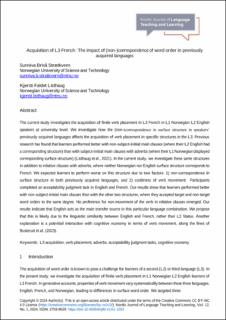| dc.contributor.author | Strætkvern, Sunniva Briså | |
| dc.contributor.author | Listhaug, Kjersti Faldet | |
| dc.date.accessioned | 2024-04-24T08:25:18Z | |
| dc.date.available | 2024-04-24T08:25:18Z | |
| dc.date.created | 2024-04-18T12:42:40Z | |
| dc.date.issued | 2024 | |
| dc.identifier.citation | Nordic Journal of Language Teaching and Learning (NJLTL). 2024, 12 (1), 27-42. | en_US |
| dc.identifier.issn | 2703-8629 | |
| dc.identifier.uri | https://hdl.handle.net/11250/3127869 | |
| dc.description.abstract | The current study investigates the acquisition of finite verb placement in L3 French in L1 Norwegian L2 English speakers at university level. We investigate how the (non-)correspondence in surface structure in speakers’ previously acquired languages affects the acquisition of verb placement in specific structures in the L3. Previous research has found that learners performed better with non-subject-initial main clauses (where their L2 English had a corresponding structure) than with subject-initial main clauses with adverbs (where their L1 Norwegian displayed corresponding surface structure) (Listhaug et al., 2021). In the current study, we investigate these same structures, in addition to relative clauses with adverbs, where neither Norwegian nor English surface structure corresponds to French. We expected learners to perform worse on this structure due to two factors: 1) non-correspondence in surface structure in both previously acquired languages, and 2) costliness of verb movement. Participants completed an acceptability judgment task in English and French. Our results show that learners performed better with non-subject-initial main clauses than with the other two structures, where they accepted target and non-target word order to the same degree. No preference for non-movement of the verb in relative clauses emerged. Our results indicate that English acts as the main transfer source in this particular language combination. We propose that our results are best accounted for by property-by-property models, and we argue that decisive factors are typological similarity between the L2 and L3, as well as cognitive economy in terms of verb movement. | en_US |
| dc.language.iso | eng | en_US |
| dc.publisher | Department of Foreign Languages and Translation, University of Agder | en_US |
| dc.rights | Navngivelse-Ikkekommersiell 4.0 Internasjonal | * |
| dc.rights.uri | http://creativecommons.org/licenses/by-nc/4.0/deed.no | * |
| dc.title | Acquisition of L3 French: The impact of (non-)correspondence of word order in previously acquired languages | en_US |
| dc.title.alternative | Acquisition of L3 French: The impact of (non-)correspondence of word order in previously acquired languages | en_US |
| dc.type | Peer reviewed | en_US |
| dc.type | Journal article | en_US |
| dc.description.version | publishedVersion | en_US |
| dc.source.pagenumber | 27-42 | en_US |
| dc.source.volume | 12 | en_US |
| dc.source.journal | Nordic Journal of Language Teaching and Learning (NJLTL) | en_US |
| dc.source.issue | 1 | en_US |
| dc.identifier.doi | 10.46364/njltl.v12i1.1203 | |
| dc.identifier.cristin | 2262704 | |
| dc.relation.project | Norges forskningsråd: 324318 | en_US |
| cristin.ispublished | true | |
| cristin.fulltext | original | |
| cristin.qualitycode | 1 | |

